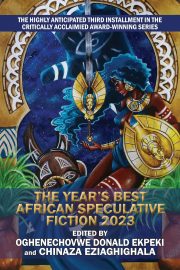Anatomy of a Tabletop Adventure
By Austin Conrad
Writing in the genre of tabletop games has a lot of similarities to fiction writing when it comes to character, plot, and setting. However, the needs of interactive fiction require the adventure game writer to adapt how they approach narrative structure and typographical presentation. To understand how these two creative endeavors differ, we’ll look at adventures written for a traditional gameplay format, such as that popularized by Dungeons & Dragons, where one player, the gamemaster, is running the adventure for two to four other players, the characters.
A gamemaster who wants to empower players’ creativity should focus on diversity of action and diversity of opportunity. Varied action encourages excitement and mitigates boredom, while varied opportunity encourages all players to participate in the story. Remember, the adventure writer’s job is not to tell a story; it’s to facilitate the players discovering their own story during play.
Hook
The function of a hook in fiction and in game writing is identical: to seize the audience’s interest, establish the story’s tone, and determine the character’s motive. Unlike fiction, when writing an adventure, the character’s motive, by definition, is unknown. However, there are two common categories:
- Narrative
- Mechanical
Narrative motives weave the adventure into the character’s ongoing story. Writers can encourage these by providing plot threads where the gamemaster can insert established characters. For an example from my own work, in the RuneQuest adventure The Throat of Winter, the players must rescue a kidnapped child from a mythological monster. This is a useful narrative thread for the gamemaster because the specific child isn’t significant; the gamemaster can place pretty much any noncombatant into that role (like a grandparent or a spouse) and still have a coherent adventure.
In contrast, mechanical motives draw upon the player’s motives rather than their character’s motives. I like to think of these as “character sheet” motives because they tend to focus on using, improving, or acquiring abilities the player can use to engage with the game. This is one reason the tavern trope is effective. “You’re all in a tavern, and a mysterious stranger offers a purse of gold if you’ll drive away the local bandits” is an opening hook so common as to be cliché. It works though, because greed blends both narrative and mechanical motives, given the mercenary context of most tabletop games.
Overall, the adventure writer should provide several reasons why the characters might accept the call to adventure. I recommend including a personal connection, a community connection, the promise of a generic reward, or the promise of a special reward as hypotheticals from which the gamemaster may choose.
Line
Like fiction, a game adventure requires a series of challenges prior to the climax. Unlike fiction, an adventure’s challenges and resolutions are more often external than internal. This is a consequence of audience participation in the story. The writer devises problems, the gamemaster plays those problems, and the characters respond externally, internally, or both. It’s important to preserve player agency in the story by avoiding dictates of emotion, action, or belief.
Once again, the diversity of challenges is key to creating a satisfying “middle act” for an adventure. In many games, this portion takes place in a dungeon, a physical environment that the players explore while trying to accomplish their objective. Dungeon design is too extensive a topic for this discussion, but whether you’re writing a dungeon or a series of challenges not tied to a location, remember to vary the type of challenge, providing diverse opportunities for the use of character abilities to solve problems. As more abilities are used, the characters experience attrition—an adventure’s analogue to a character’s low point in fiction.
The emotional tone to strive for through specific challenges is that the characters are bruised but remain determined to succeed. No single guide will determine the correct amount of attrition. The difficulty of a challenge is contextual to the game system.
Sinker
A satisfying conclusion to an adventure has structural differences from the conclusion of a fiction story. The adventure’s climax and denouement should be open-ended because they rely on the players’ choices, not the writer’s. Tabletop game players feel betrayed when an adventure takes them to a foregone conclusion as though following railroad tracks. The beauty of game writing is developing problems and problem-solving tools that others will then use to discover their own journey.
Mainstream adventures often conclude with a climactic combat between the characters and a major villain, a conflict that should be presented in a clean, straightforward manner. A paragraph or two of tactical advice is sufficient—especially if the villain has abilities that are infrequently used. The writer shouldn’t force the gamemaster to peruse several pages and slow down the game.
The writer must account for the players’ success or failure in the conclusion, setting the tone for the adventure’s finale. For example, they must describe whether the players’ victory is joyful or bittersweet, as best suits the game system. The actions of nonplayer characters, their opinions of the players, and seeds of future adventures are common elements sown into the concluding pages.
Typography
The writer’s use of typographical elements can also convey information to the gamemaster. This is a technical aspect of adventure game writing that doesn’t have a direct parallel in fiction. Implementing boldface, italics, bullet lists, alternate typeface colors, and other visual aids helps the gamemaster quickly spot information on the page. This speeds up play and improves the experience the gamemaster—and therefore, the players—will have. For example, the writer can use boldface to indicate an ability players should use to succeed at the challenge. The success or failure of that ability can then be listed with bullet points. While some of these elements of presentation are the domain of the layout artist, it’s still the adventure writer’s task to account for these tools while writing their manuscript. I’ve utilized them throughout this article to demonstrate their efficacy.
 Austin Conrad is a full-time writer and game designer. He is best known for his indie publications for RuneQuest. His work for other systems has been published by EN Publishing and Menagerie Press. Austin’s most recent release is “To Hunt a God,” an adventure in which the players quest into a magical forest to perform an act of divine euthanasia. You can learn more about Austin’s work on his website, akhelas.com.
Austin Conrad is a full-time writer and game designer. He is best known for his indie publications for RuneQuest. His work for other systems has been published by EN Publishing and Menagerie Press. Austin’s most recent release is “To Hunt a God,” an adventure in which the players quest into a magical forest to perform an act of divine euthanasia. You can learn more about Austin’s work on his website, akhelas.com.


